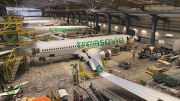Autumn is a time of aircraft revision and maintenance. For years, it has been the moment chosen by the organisers to hold the highest ranking MRO event in Europe. This event, MRO Europe, is taking place in Madrid on 7-8-9 October 2014 at the initiative of our sister publication, Aviation Week. Last week, in a lead-up to this event, we at AJPAE* decided to invite the top man at Air France-KLM’s maintenance branch (an account was published in these chronicles).
So now it’s time to cast an eye over the sector as a whole, although it is rather difficult to distinguish between what is going on at a European (let alone French) level and a global level.
MRO represents a global market of almost US $ 61 billion, but it is not an equal field, as shown by figures from aviation consultant ICF-SHE last May. Aircraft maintenance repair and overhaul (MRO) is divided up as follows: 40% for engines, 22% for equipment, 17% for line maintenance, 15% for airframes, with aircraft modifications making up the final 6%.
Engines are a particularly active sector but also tend to be a captive market for engine manufacturers. Airframe maintenance is labour intensive and so-called “low-cost countries” are thus favoured. This may well change. Line maintenance is usually carried out by airlines, indeed the “low-costs” manage this activity directly, although usually by outsourcing. Adjustments are mainly required in order to keep up with new services offered by airline companies.
Then there remains the aircraft equipment MRO sector, a vast sector, representing 22% of the MRO market. There are many different players involved here. Indeed airlines such as Air France-KLM and Lufthansa have been careful not to let the chance slip away, setting up new ways of picking up business. Air France Industries-KLM E&M has a site at the end of the Orly runways, Eole, which focuses on mechanical and electromechanical equipment, and also a subsidiary in the Netherlands, Epcor, which works mainly in the field of auxiliary power units (APU). And the Franco-Dutch firm has created a joint venture with Aircelle for maintenance of nacelles in Dubai. Lufthansa Technics, which holds the pole position in terms of MRO, is determined to hang on to its lead: in addition to its Hamburg workshops given over to equipment repair, it has set up a subsidiary in China, Shenzhen to be precise, for maintenance and repair of nacelles.
These are just a few examples. But it’s clear to see why aeronautical equipment maintenance is a very active MRO sector, since no equipment can be “out of service” if an aircraft is to take to the air.
As a result, the equipment MRO sector is particularly in demand not only by airlines who count on reliability, but also by the manufacturers themselves, who have understood that their (now more reliable) products tend to generate less cash in terms of sales than in the past, and that maintenance could conveniently make up for the lack of growth in spare parts.
OEMs of all origins and types are therefore attempting to swell their market shares by setting up MRO units close to operators using their systems. Liebherr Aerospace, Zodiac Aerospace, Safran (and its subsidiaries), UTC: all these reputable equipment manufacturers have set up units capable of repairing their own equipment. Which is not always to the taste of the independents. But there again, a balance will emerge, since no one player can handle all MRO on a global level.
For Aeromorning, Nicole B.
Translated by L. Jones















Be the first to comment on "Aircraft maintenance flying high"